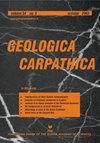Geochemistry and tectonic significance of metamorphosed mafic ophiolitic rocks in the upper high-grade basement unit of the eastern Rhodope Massif (Bulgaria–Greece)
IF 1.5
4区 地球科学
Q4 GEOSCIENCES, MULTIDISCIPLINARY
引用次数: 1
Abstract
: Metamorphosed mafic ophiolitic rocks in the metamorphic section of the eastern Rhodope Massif in Bulgaria and Greece are important for understanding the oceanic lithosphere fragments, which have been involved in Alpine tectonic–metamorphic processes. Petrography and mineral compositions of the meta-mafic rocks (mostly gabbro–basalt to minor diorite–andesite) point to main amphibolite-facies overprint, which strongly obliterated the primary textures, and the original igneous grain-sizes are partly preserved only of the plagioclase. The meta-mafic rocks are classified as low-K and low- to high-Ti tholeiitic affinity igneous protoliths of basaltic to andesitic compositions, in which high-Ti and low-Ti groups are identified on the basis of Ti concentrations. They also differ with respect to trace element and REE characteristics. A complex chemistry of high-Ti group indicates an origin primarily from MORB mantle source, subsequently modified by subduction-zone derived LILE- and REE-enriched melts and contribution of HFSE-enriched component that produce the oceanic island tholeiites. The low-Ti group displays IAT affinity, with clearly defined subduction-related component demonstrated by LILE enrichment, HFSE and HREE depletion relative to N-MORB and negative Nb and Ti anomalies, all indicative for an island arc petrogenesis. A single dunite sample studied also displays geochemical characteristics of the low-Ti group meta-mafic rocks. Geochemical diversity of the meta-basic rocks with MORB, transitional MORB/IAT and IAT affinities hints their supra-subduction zone (SSZ) origin in an island arc/ back-arc system, with identifiable arc-related and rifting/sea-floor spreading magmatic products represented by the low-Ti and high-Ti groups, respectively. At present, the available Middle-Late Paleozoic/Early Triassic radiometric ages of the meta-mafic rocks protoliths predominate over the Early Paleozoic ages, which suggests that the development of the inferred arc/back-arc system relates mostly to the ocean-floor magmatic evolution of the Paleotethyan realm.保加利亚-希腊罗多佩地块东部上高品位基底单元变质基性蛇绿岩地球化学及其构造意义
保加利亚和希腊罗多普地块东部变质段的变质基性蛇绿岩对认识海洋岩石圈碎屑具有重要意义,这些岩石圈碎屑参与了高寒构造变质作用。变质基性岩(以辉长玄武岩为主,少量闪长安山岩为主)的岩石学和矿物组成指向主要的角闪岩相覆印,强烈地掩盖了原始结构,仅斜长石部分保留了原始火成岩粒度。将变质基性岩石划分为玄武岩-安山岩成分的低钾和低至高钛亲和拉斑岩火成岩原岩,并根据其Ti含量划分出高钛和低钛组。它们在微量元素和稀土元素特征方面也存在差异。高ti族的复杂化学特征表明其主要来源于MORB地幔源,随后受到俯冲带衍生的LILE-和ree富集熔体以及富hfse组分的影响,形成了洋岛拉斑岩。低Ti组表现出IAT亲和力,具有明确的俯冲相关成分,LILE富集,相对于N-MORB的HFSE和HREE亏损,以及负Nb和Ti异常,均表明岛弧岩石成因。研究的单一泥质岩样品也显示了低钛群变质基性岩石的地球化学特征。具有MORB、过渡性MORB/IAT和IAT亲缘关系的变质基性岩地球化学多样性暗示其超俯冲带(SSZ)起源于岛弧/弧后体系,具有可识别的弧相关岩浆产物和裂谷/海底扩张岩浆产物,分别以低ti和高ti组为代表。目前已有的中-晚古生代/早三叠世变质基性岩石原岩的辐射年龄大于早古生代,表明推断出的弧/弧后体系的发育主要与古特提斯领域的海底岩浆演化有关。
本文章由计算机程序翻译,如有差异,请以英文原文为准。
求助全文
约1分钟内获得全文
求助全文
来源期刊

Geologica Carpathica
地学-地球科学综合
CiteScore
2.40
自引率
23.10%
发文量
26
审稿时长
>12 weeks
期刊介绍:
GEOLOGICA CARPATHICA covers a wide spectrum of geological disciplines including geodynamics, tectonics and structural geology, volcanology, stratigraphy, geochronology and isotopic geology, karstology, geochemistry, mineralogy, petrology, lithology and sedimentology, paleogeography, paleoecology, paleobiology and paleontology, paleomagnetism, magnetostratigraphy and other branches of applied geophysics, economic and environmental geology, experimental and theoretical geoscientific studies. Geologica Carpathica , with its 60 year old tradition, presents high-quality research papers devoted to all aspects not only of the Alpine-Carpathian-Balkanian geoscience but also with adjacent regions originated from the Mediterranean Tethys and its continental foreland. Geologica Carpathica is an Official Journal of the Carpathian-Balkan Geological Association.
 求助内容:
求助内容: 应助结果提醒方式:
应助结果提醒方式:


